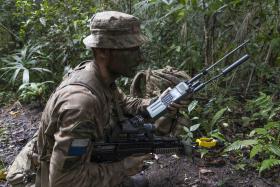Airborne signallers are testing the Army’s new radios in the jungle, the most challenging environment for radio communications to work.
Colchester-based 216 (Parachute) Signal Squadron has taken the Multi-Mode Radio to Belize to test the full range of its capabilities on Exercise Mercury Canopy. The jungle provides a stern test for communication systems as the dense and moist vegetation absorbs radio waves and limits line of sight transmission. Also, like any electronic equipment, radios require careful handling and maintenance to protect them in the hot and humid conditions.
Major Liam Crane, Officer Commanding 216 (Para) Sig Sen, said: “As a signal squadron, we would normally deploy in support of other units, but Belize has been a fantastic and unique opportunity for us to focus on learning by doing. We have used some of the newest and most advanced technology that the Army has, while surviving in the jungle, to really push the boundaries of expeditionary communications.”
The new MMR is a dual-channel radio, enabling simultaneous voice and data communications over alternative networks. It can be used by ground troops or mounted in vehicles and is operated by other NATO militaries, improving our ability to work together. More than 1,300 MMRs have been purchased for use by all three services through a £90 million programme with L3Harris Communications Systems UK.
Maj Crane said: “MMR is two radios in one. It provides line-of-sight voice and data over wideband radio between a unit on the ground, while simultaneously communicating anywhere in the world via satellite. The mesh networking capabilities mean that we can run applications so troops out in the Belizean jungle and back at our headquarters in Colchester are working off the same information at the same time.”
MMR is set to replace Bowman as the Army’s tactical communication and information system.
Information systems engineer Sergeant Tom Gale said: “Modern operations use a huge amount of data, and while Bowman was good in its day it just can’t transmit the amount of data we now need, but MMR gives us that bandwidth. MMR has performed very well out in the jungle. It’s been a real challenge for us to learn how to use equipment that’s new to the Army with new capabilities. We’ve hit speed bumps but worked out how to use the equipment to get around them every time, and that’s been very rewarding.”
Beyond MMR’s versatility, a key benefit is the smaller and more energy-efficient package it comes in.
Maj Crane said: “With water, rations and ammunition, soldiers can be carrying up to 60kg. MMR fits in a webbing pouch where a Bowman radio can take up half of a daypack. Operating in the heat, humidity and tough terrain of the jungle, we’re really feeling the benefit of that reduced bulk.”
Source:
British Army Press Office. Images captured by Cpl. Danny Houghton
Read More





Latest Comments
There are currently no comments for this content.
Add Comment
In order to add comments you must be registered with ParaData.
If you are currently a ParaData member please login.
If you are not currently a ParaData member but wish to get involved please register.